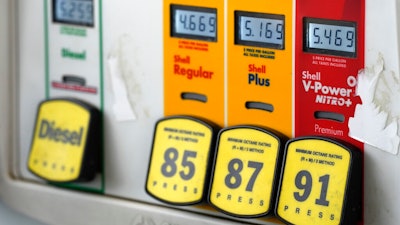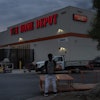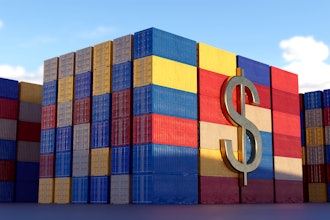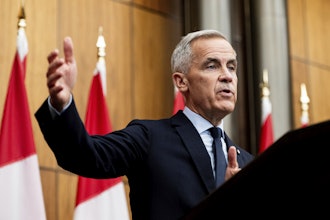
DALLAS (AP) — There is little evidence that gasoline prices, which hit a record $5 a gallon on Saturday, will drop anytime soon.
Rising prices at the pump are a key driver in the highest inflation that Americans have seen in 40 years.
Everyone seems to have a favorite villain for the high cost of filling up.
Some blame President Joe Biden. Others say it's because Russian President Vladimir Putin recklessly invaded Ukraine. It's not hard to find people, including Democrats in Congress, who accuse the oil companies of price gouging.
As with many things in life, the answer is complicated.
WHAT IS HAPPENING?
Gasoline prices have been surging since April 2020, when the initial shock of the pandemic drove prices under $1.80 a gallon, according to government figures. They hit $3 in May 2021 and cruised past $4 this March.
On Saturday, the nationwide average for a gallon ticked just above $5, a record, according to auto club AAA, which has tracked prices for years. The average price jumped 18 cents in the previous week, and was $1.92 higher than this time last year.
State averages ranged from $6.43 a gallon in California to $4.52 in Mississippi.
WHY IS THIS HAPPENING?
Several factors are coming together to push gasoline prices higher.
Global oil prices have been rising — unevenly, but sharply overall — since December. The price of international crude has roughly doubled in that time, with the U.S. benchmark rising nearly as much, closing Friday at more than $120 a barrel.
Russia's invasion of Ukraine and the resulting sanctions by the United States and its allies have contributed to the rise. Russia is a leading oil producer.
The United States is the world's largest oil producer, but U.S. capacity to turn oil into gasoline is down 900,000 barrels of oil per day since the end of 2019, according to the Energy Department.
Tighter oil and gasoline supplies are hitting as energy consumption rises because of the economic recovery.
Finally, Americans typically drive more starting around Memorial Day, adding to the demand for gasoline.
WHAT CAN BE DONE TO GET MORE OIL?
Analysts say there are no quick fixes; it's a matter of supply and demand, and supply can't be ramped up overnight.
If anything, the global oil supply will grow tighter as sanctions against Russia take hold. European Union leaders have vowed to ban most Russian oil by the end of this year.
The U.S. has already imposed a ban even as Biden acknowledged it would affect American consumers. He said the ban was necessary so that the U.S. does not subsidize Russia’s war in Ukraine. “Defending freedom is going to cost,” he declared.
The U.S. could ask Saudi Arabia, Venezuela or Iran to help pick up the slack for the expected drop in Russian oil production, but each of those options carries its own moral and political calculations.
Republicans have called on Biden to help increase domestic oil production — for example, by allowing drilling on more federal lands and offshore, or reversing his decision to revoke a permit for a pipeline that could carry Canadian oil to Gulf Coast refineries.
However, many Democrats and environmentalists would howl if Biden took those steps, which they say would undercut efforts to limit climate change. Even if Biden ignored a big faction of his own party, it would be months or years before those measures could lead to more gasoline at U.S. service stations.
At the end of March, Biden announced another tapping of the nation's Strategic Petroleum Reserve to bring down gasoline prices. The average price per gallon has jumped 77 cents since then, which analysts say is partly because of a refining squeeze.
WHY IS U.S. REFINING DOWN?
Some refineries that produce gasoline, jet fuel, diesel and other petroleum products shut down during the first year of the pandemic, when demand collapsed. While a few are expected to boost capacity in the next year or so, others are reluctant to invest in new facilities because the transition to electric vehicles will reduce demand for gasoline over the long run.
The owner of one of the nation’s largest refineries, in Houston, announced in April that it will close the facility by the end of next year.
WHO IS HURTING?
Higher energy prices hit lower-income families the hardest. Workers in retail and the fast-food industry can't work from home — they must commute by car or public transportation.
The National Energy Assistance Directors Association estimates that the 20% of families with the lowest income could be spending 38% of their income on energy including gasoline this year, up from 27% in 2020.
WHEN WILL IT END?
It could be up to motorists themselves — by driving less, they would reduce demand and put downward pressure on prices.
“There has got to be some point where people start cutting back, I just don't know what the magic point is,” said Patrick De Haan, an analyst for the gas-shopping app GasBuddy. “Is it going to be $5? Is it going to be $6, or $7? That's the million-dollar question that nobody knows.”
HOW ARE DRIVERS COPING?
On Saturday morning at a BP station in Brooklyn, New York, computer worker Nick Schaffzin blamed Putin for the $5.45 per gallon he was shelling out and said he will make sacrifices to pay the price.
“You just cut back on some other things — vacations, discretionary stuff, stuff that's nice to have but you don't need,” he said. "Gas you need.”
At the same station, George Chen said he will have to raise the prices he charges his customers for film production to cover the gas he burns driving around New York City. He acknowledged that others aren't so fortunate.
“It's going to be painful for people who don't get pay increases right away,” he said. ”I can only imagine the families who can't afford it."
___
Julie Walker in Brooklyn, New York, contributed to this report.






















